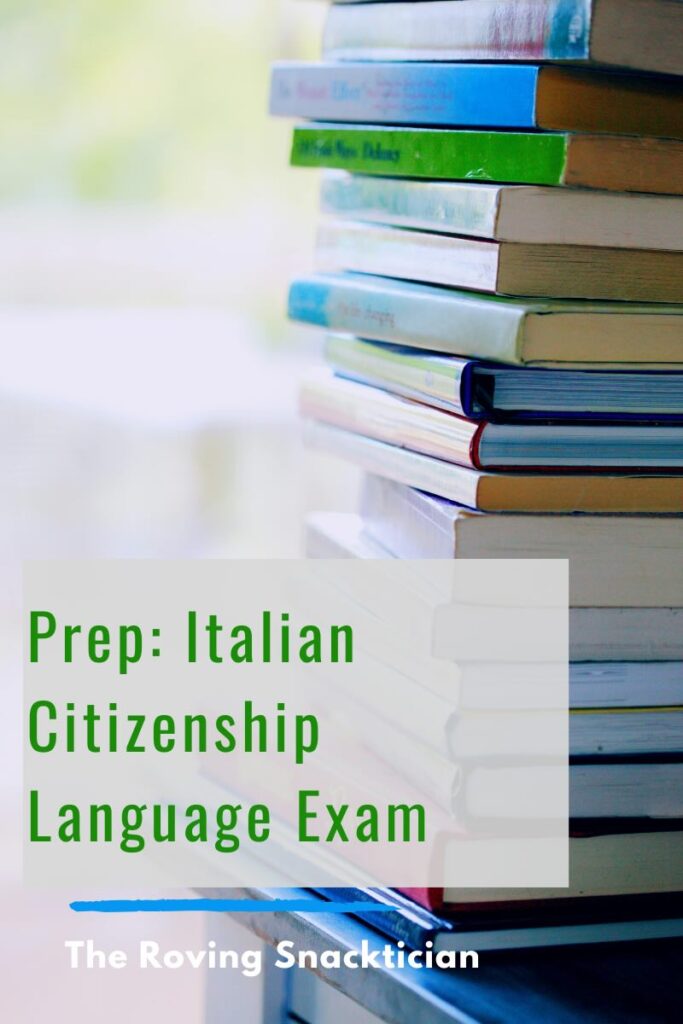
As many of you know, I had my Italian citizenship (through my ancestry) recognized several years ago. Mr Snacks is allowed to apply for Italian citizenship, as my husband however he needed to get a B1 level language certification in Italian. This series will talk about preparing for, taking and getting results of the B1 Citizenship CILS language exam. (While I was not required to take the exam, our Italian teacher strongly suggested it, as he said when a couple takes the test together, they usually get better results.)
Background
When we started this process in June 2022, neither of us spoke any Italian.
Mr Snacks spoke some Spanish (mostly present tense verbs which he learned in high school and a deeper vocabulary from traveling to Spanish speaking countries frequently). He would also have been the first to tell you he is “horrible at languages”.
I spoke intermediate level Spanish, all learned as an adult. I enjoy the process of learning another language, so studying or doing language homework isn’t tortuous to me (the same cannot be said for my husband).
Strategy
Since Mr Snacks is the only one who was planning to take the test (I only got conned into a month beforehand), the strategy for how to approach the learning was 100% his plan. In June 2022, he announced that he wanted to find a school in Italy that proctored the test, begin studying with them online, go to the school for the 1-2 months leading up to the test for in-person classes, then take the test in Italy in June 2023. He chose Florence completely on a whim because he had been and thought it sounded cool to spend time there learning.

Studying
Mr Snacks
In June, Mr Snacks reached out to several schools in Florence to find one that was a good fit. All responded immediately and one had a newbie class starting in just a few weeks. In the meantime, he got started with the basics by using the free online Rosetta Stone modules that were available from our library, and then beginning the Beginner Italian class on EdX.
He began online classes twice/week at the end of June. July and August were very frustrating, as the first school we chose (Scuola Leonardo da Vinci) wasn’t a good fit for us as the class size was too large and the instructor had not taught online before. He reached out to Parola Language School, who let him sit in on a class for free and ensure it was a good fit. He began taking this class 2 times per week, but was always a bit nervous of having lost those 2 months.
In December, he felt like he was still struggling with his speaking in Italian, so he found an instructor online who could offer him some additional one-on-one coaching. He interviewed several, but felt that Francesca at Right Way Italiano was a good fit for him. He worked with her once per week for 3 months to fill in learning gaps and practice speaking in a manner that would prepare him for the test.
In December, he bought a test prep book. He began working on this with Francesca, but the vocabulary was really a challenge for him at this point—inequality in pay, differentiated stream recycling, and why tanks are no longer used in military parades are not really topics you feel ready to tackle after only 3 months of serious language learning!
In mid-April, we arrived in Florence and began in-person classes. He took group classes 5 days per week— 4 hours per day (2 hours of grammar, 2 hours of conversation). Maybe two weeks before the test, he felt his time would be better spent doing focused test prep instead of classes, so he dropped the conversation classes.
While we thought there would be a B1 prep class, there were not enough students enrolled, so we worked with a Parola teacher once or twice per week specifically focused on the test.
Mrs Snacks
I also started with Rosetta Stone, EdX, and the challenges of finding the correct online class. While we were searching to find “our” class, I continued on with EdX. When Mr Snacks found the Parola online class, they were slightly behind where I had learned in EdX. I decided to wait a few weeks until the class caught up to what I learned. I took the online classes with Parola 2 times/week from October-March.
I arrived in Florence with grand plans of learning a little Italian, but mostly living a life of leisure. Our Italian teacher promptly encouraged me to enroll for the test, and suddenly studying became a lot more urgent. I took 2 hours of conversational classes 3 times per week, plus the test-prep private sessions with Mr Snacks.
Additionally, the test prep book Mr Snacks started on in December, I now had to power through in just a few weeks! As well, throughout our studying time, I used the vocabulary-building app Drops from December through June.
Along with Mr Snacks, I attended B1 prep sessions one or two times per week specifically focused on the test.

Books
We were advised to get this book, and I would advise it if you are also studying for the test. It is similar in style to the kinds of readings, listening and topics you might get on your test. There is no overlap between this book and any question I saw on our test. (I had secretly hoped I would get to something on the test and do well because it had been in my book—that seems to be NOT how this book is set up.)
This book will force you to get better in topics you may not learn naturally—but ones that are on the citizenship language test. Unemployment, pensions, equality in marriage, renting an apartment, writing to a school director about the cafeteria menu… For me, the audio exercises were extremely helpful in getting me prepared.
If you can fairly easily pass the tests in this book, it is likely you will do well on the B1 CILS.
Test Prep
What I didn’t understand at the beginning is that there are two types of learning required to pass this test—
- The Italian language fundamentals
- The passing the CILS piece
For the first many months, all you need is the Italian language piece. Mr Snacks wanted it to learn from someone who would proctor the test, so he would feel more relaxed when he took the test—but this is completely optional. Anyone who teaches Italian can get you to B1 level skill. Generally speaking, you will need to know: presente, passato prossimo, imperfetto, condizionale, condizionale composto, futuro, futuro anteriore, pronomi diretti/indiretti/combinati, riflessivi, ci & ne, pronomi relative.
Passing the CILS requires someone who has a decent amount of experience with the test. We had one teacher who was able to read up and give us guidance on what kinds of things would be on the test—but we found it very useful to work with someone who has seen previous tests, could coach on the writing style needed for the exams, knew specifically how the grading on the written comprehension would be graded, and to hold practice speaking sessions with you using past examples. They will teach you how the Scantron bubbles work in Italy (it is NOT how they work in the US). And also, you will learn the tricky in’s and out’s in the test (you need a certification from your doctor to do any sport, how a job posting works, and how to really carefully read for tricky answers—think back to SAT tests). But, again, you only really need this once you have your B1 fundamentals nailed.
Ready or Not!
Come early June, we had written what felt like 1000 fake emails to landlords, school directors, real estate agents and the like. We’d practiced introducing ourselves, talking about our favorite movies, favorite trips, and how we liked to spend our free time. We had covered our apartment in post-its to help us recall phrases we would likely need to recall (in attesa di una sua gentile risposta). We had taken every multi choice test in our prep book a few times. That meant it was finally time to head in and take the test!

2 Replies to “Prep: Italian Citizenship Language Exam”
Comments are closed.